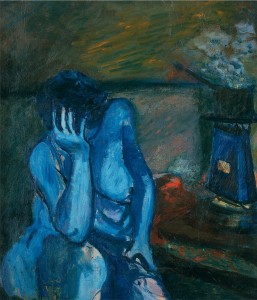This fascination with the spiritual and sometimes mystical foundations which are “higher than art” continued into the 20th century, encompassed the entire work of Mikhail Vrubel, left its mark on the artists of the Blue Rose society, and permeated the philosophy of art espoused by Wassily Chekrygin, who inspired the fundamental school of Russian postavant-gardism. It is interesting to note that these same spiritualistic meanings served as general principles in the works of Wassily Kandinsky, Alexei Jawlensky, and Marc Chagall, the three official representatives of Russia in the international history of expressionism. Therefore, there is no basis for saying that units of meaning and technical elements that could be labelled “expressionistic” were directly transferred into the discourse of the Russian avant-garde. One could always analyze all sorts of features in Russian art in terms of their correspondence to western European prototypes, but how much progress could such a thought pattern really make, apart from producing a condescending affection for “provincial replicas”? It is obvious that the paths trodden by the Fauvists in France and the Bru.cke artists in Germany were absolutely unique and contained fascinating meanings. But what is important is that these meanings did not exhaust the culture of expressionism. This culture was constantly changing and developing and Russian art brought into expressionism its own intonations and articulations.
Expressionist art is where man meets those states of being that are not seen in the outward pretense of culture. This is why form is not important here. Or rather, it is important only to the degree that it reflects the artist’s simultaneous experience of both the inadequacy and excessiveness of any form or material.
In his article “Masks”, published in The Blue Rider Almanac, August Macke wrote, “Any true art form arises from a person’s constantly changing attitude towards the materials that constitute the naturallyoccurring art form under consideration. A flower’s fragrance, the elated bounding of a dog, a dancer, a decorative design, a cathedral, this or that image or style, the life of the common people, a given era … What gives birth to art forms and styles is tension.” Furthermore, “Forms are the intense expression of an intense life. Differences find their expression in materials, words, colors, sounds, stone, wood, metal. Not every form needs to be comprehended, just as not every language needs to be read.” [6] Comprehension is a meta language. Comprehension is art. This is why this language is considered to be perpetually inadequate. It is as though the artist does not have sufficient means to say everything that ought to be said, or to portray on the canvas everything that demands to be portrayed. Of course, here we do not mean those means or methods of expression that history has bequeathed to the artist. What the artist learns from the experience of the past is like gathering footprints or impressions of others’ actions or the results of others’ efforts. But this does not yet mean that the artist himself has taken part in the action.




Капитановский Александр
25 Aug 2012
Встретил Ваши тексты, прежде не довелось. Теперь читаю. С благодарностью и уважением.